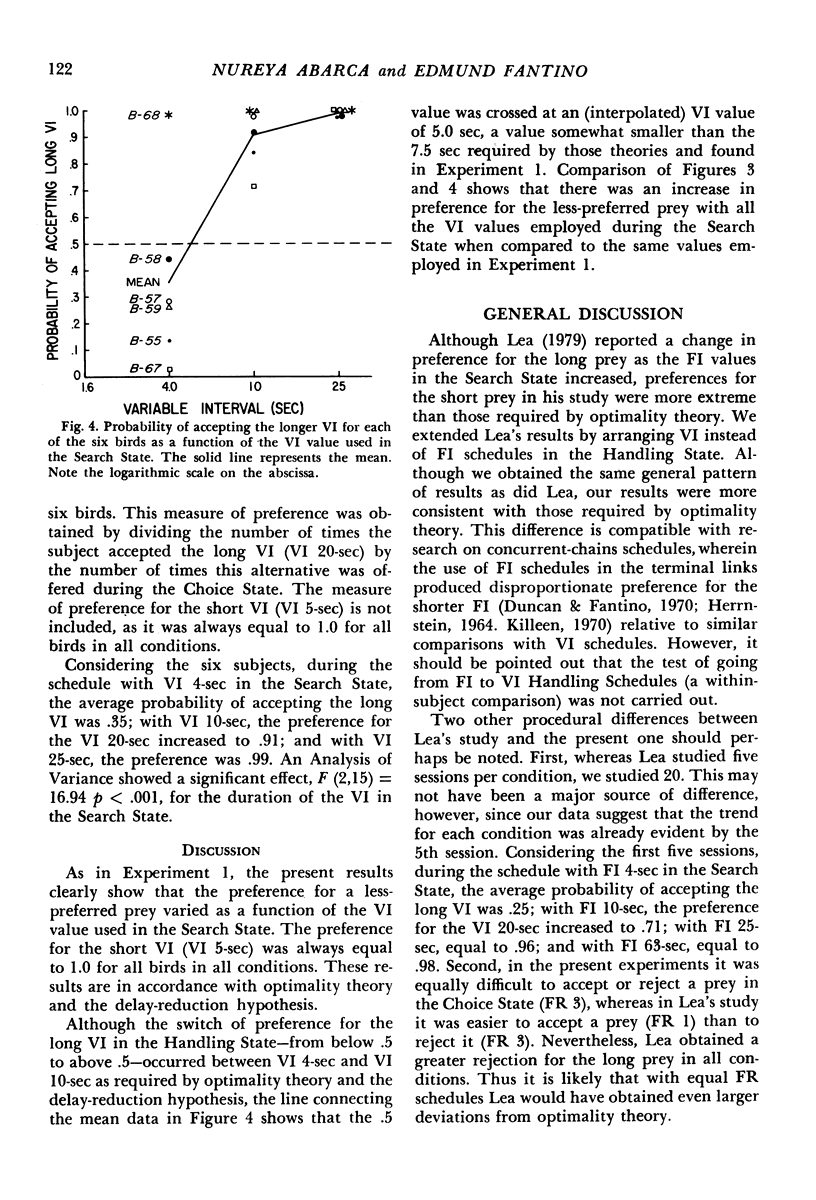Abstract
In Experiment 1, six naive pigeons were trained on a foraging schedule characterized by different states beginning with a search state in which completion of a fixed-interval on a white key led to a choice state. In the choice state the subject could, by appropriate responding on a fixed ratio of three, either accept or reject the schedule of reinforcement that was offered (either a variable-interval five-second or a variable-interval 20-second). If the subject accepted the schedule, it entered a “handling state” in which the appropriate variable-interval schedule was presented. Completion of the variable-interval schedule produced food. The independent variable was the fixed-interval value in the search state, and the dependent variable was the rate of acceptance of the long variable-interval in the choice state. Experiment 2 was identical except that the search state required completion of a variable-interval, instead of a fixed-interval, schedule. The rate of acceptance of the long variable-interval schedule in both experiments was a direct function of the length of the search state, in accordance with both optimality theory and the delay-reduction hypothesis.
Keywords: foraging, choice, optimality theory, delay-reduction hypothesis, concurrent-chains schedules, fixed-interval schedules, variable-interval schedules, key peck, pigeons
Full text
PDF






Selected References
These references are in PubMed. This may not be the complete list of references from this article.
- Baum W. M., Rachlin H. C. Choice as time allocation. J Exp Anal Behav. 1969 Nov;12(6):861–874. doi: 10.1901/jeab.1969.12-861. [DOI] [PMC free article] [PubMed] [Google Scholar]
- Brown P. L., Jenkins H. M. Auto-shaping of the pigeon's key-peck. J Exp Anal Behav. 1968 Jan;11(1):1–8. doi: 10.1901/jeab.1968.11-1. [DOI] [PMC free article] [PubMed] [Google Scholar]
- Duncan B., Fantino E. Choice for periodic schedules of reinforcement. J Exp Anal Behav. 1970 Jul;14(1):73–86. doi: 10.1901/jeab.1970.14-73. [DOI] [PMC free article] [PubMed] [Google Scholar]
- Fantino E. Choice and rate of reinforcement. J Exp Anal Behav. 1969 Sep;12(5):723–730. doi: 10.1901/jeab.1969.12-723. [DOI] [PMC free article] [PubMed] [Google Scholar]
- HERRNSTEIN R. J. APERIODICITY AS A FACTOR IN CHOICE. J Exp Anal Behav. 1964 Mar;7:179–182. doi: 10.1901/jeab.1964.7-179. [DOI] [PMC free article] [PubMed] [Google Scholar]
- HERRNSTEIN R. J. Relative and absolute strength of response as a function of frequency of reinforcement. J Exp Anal Behav. 1961 Jul;4:267–272. doi: 10.1901/jeab.1961.4-267. [DOI] [PMC free article] [PubMed] [Google Scholar]
- Herrnstein R. J. On the law of effect. J Exp Anal Behav. 1970 Mar;13(2):243–266. doi: 10.1901/jeab.1970.13-243. [DOI] [PMC free article] [PubMed] [Google Scholar]
- Killeen P. Preference for fixed-interval schedules of reinforcement. J Exp Anal Behav. 1970 Sep;14(2):127–131. doi: 10.1901/jeab.1970.14-127. [DOI] [PMC free article] [PubMed] [Google Scholar]
- Squires N., Fantino E. A model for choice in simple concurrent and concurrent-chains schedules. J Exp Anal Behav. 1971 Jan;15(1):27–38. doi: 10.1901/jeab.1971.15-27. [DOI] [PMC free article] [PubMed] [Google Scholar]


